Sounds like a dream, right?
After all, how can your content practically stand out and get noticed when more than 2 million blog posts are published every day?
You’re competing with much bigger brands and don’t have thousands to spend on advertising like they do.
Clearly, you don’t stand a chance.
But what if I tell you the simple, yet mostly overlooked, process smart marketers use to hack their content strategy, rise above their competitors and turn first-time visitors into email subscribers?
Tall claim, I know.
Here’s how you can create content that cuts through all the noise and leaves your readers begging for more.
1. Understand the Needs of Your Target Audience
This is the key to creating content that build loyalty.
Knowing your audience and spending time to understand their needs is an extensive process. But the usefulness of your content depends heavily on it.
If you’ve been in business for a while, you’d certainly have a general idea of what your target audience wants to read about.
But don’t assume the details.
There are enough free tools and resources on the web to give you a much better understanding of their needs.
Start with Facebook.
Go to Facebook Ads Manager→Audience Insights and create a new audience.
Enter your target country in the location tab, and add some of your well-known competitors and general audience interests in the interest field.
For example, here are a few interests I entered to research my audience for a blog on WordPress related topics.
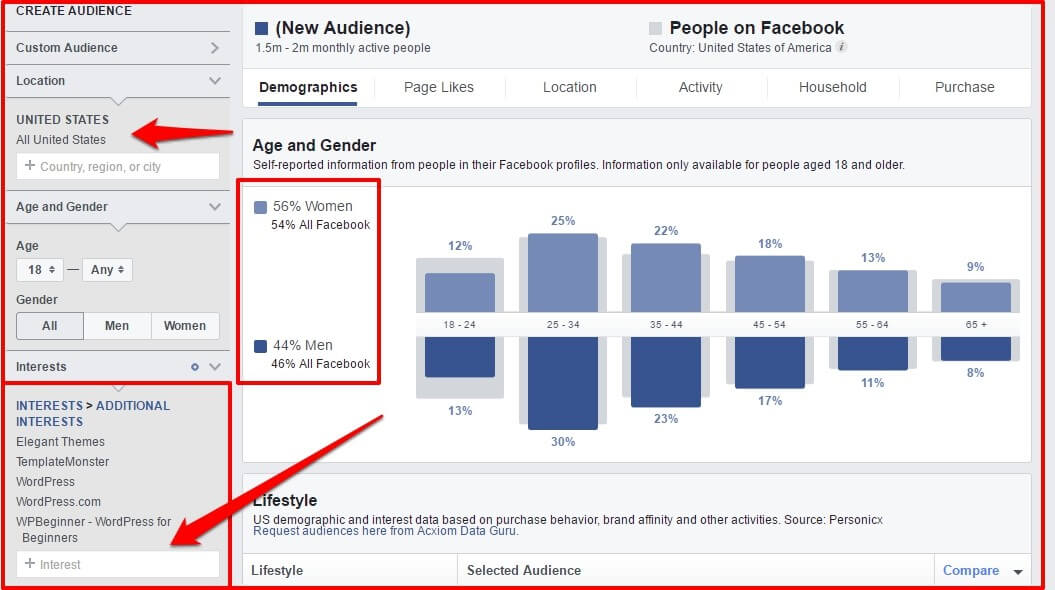
Straightaway, Facebook gives you a wealth of information about people with these interests. You could see more than half of my audience is female and most of them are between 25-44 years of age.
When you scroll down, it gives you information about their lifestyle, relationships and the industries they work in.
The “Page Likes” tab reveals even more
![]()
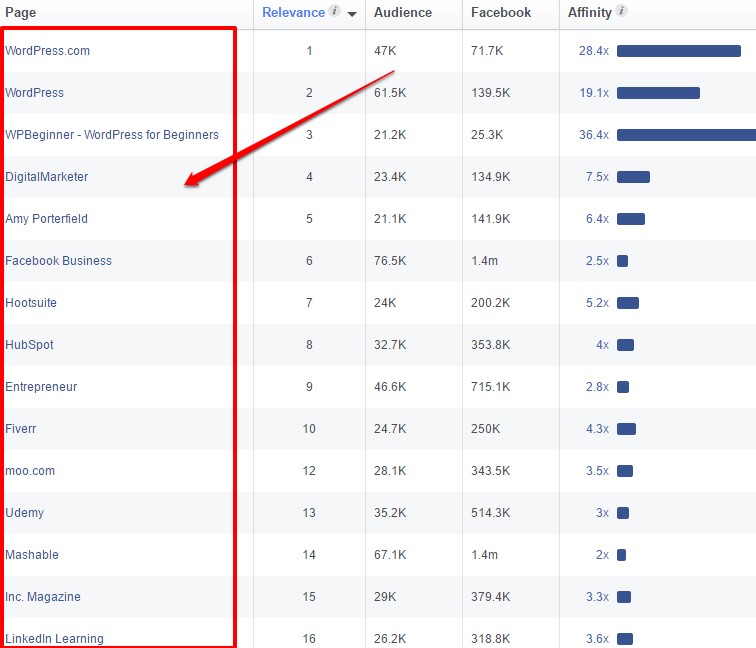
These are the Facebook Pages liked by my target audience.
To understand what kind of content they like, I can simply head over to each of these pages and see the posts with the highest engagement and comments.
I can also visit their blogs and read their most popular posts to know what’s working for them.
There’s an even better way to use this information.
Go to BuzzSumo and enter each of these websites to find their most frequently shared content.
For example, here’s what I got when I searched for Wpbeginner.com on BuzzSumo
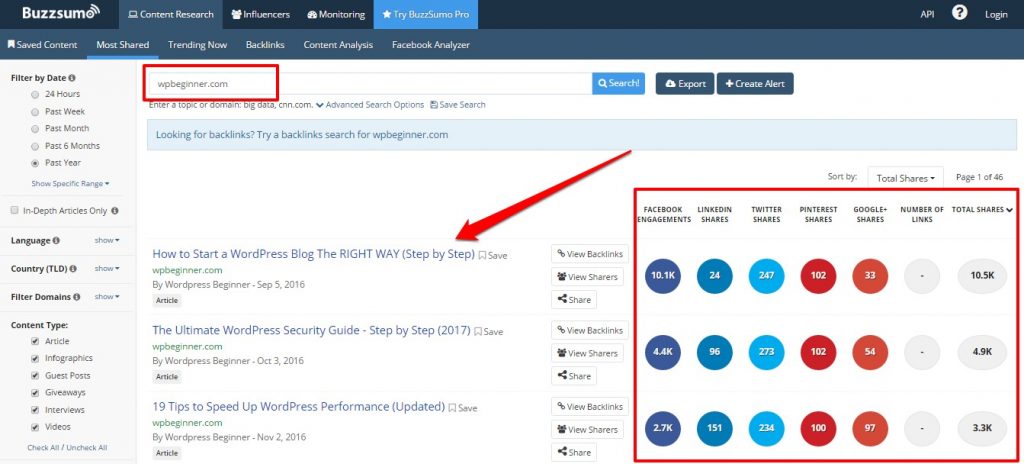
You can also use this tool to find posts with the highest number of backlinks from other sites.
Don’t just study the headlines of these posts.
Analyze them in detail. Look at the length of the content, the number of images, snapshots or videos used and the structure of the content (headings, subheadings etc.).
This gives you a much better understand of what your audience really wants to read about.
2. Target the Questions No One’s Answering
Now that you know what your audience wants to read, just start replicating what your competitors are doing, right?
Not so fast.
Replicating successful content is not the objective. You need to go a step further and create an even better and more useful version of the existing content.
How do you do that?
By simply identifying its loopholes and targeting the questions no one’s answering.
There are several ways to find unanswered questions.
First of all, look at the comments on the most popular blog posts on your topic. Skip the meaningless “great post” and “nice work” kind of comments and look for the hidden gems.
You’d always find them if you look hard enough.
For example, Ahrefs wrote a several thousand word guide on the importance of anchor text in SEO.
But just a quick look at the comments gave me several improvement areas.



There are hundreds of comments on the post so I can definitely find more useful comments if I spend a bit more time on this.
But here’s the point.
You can use the questions and the observations in these comments to create a more well-rounded post.
The same approach can be used on Amazon, the largest collection of eBooks on the web. Just find the most popular books related to your topic and look at the user comments to identify any loopholes.
Keep an eye on comments rated 3-star or below in particular because that’s where you’ll find the improvements areas in the product.
For example, here are a few comments from dissatisfied customers of the bestselling Content Marketing books on Amazon.

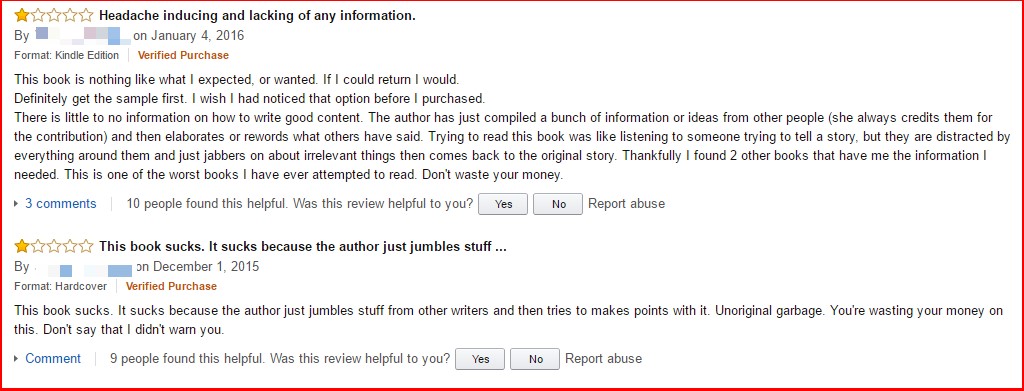
Just a few of these comments can give you dozens of ideas on how you can make the existing content, which is already popular, even better.
If you keep publishing content that addresses rarely answered questions, you’ll soon build a loyal fan base that waits for new posts on your blog.
3. Create Well-Researched, Data-Heavy and Actionable Content
Even the most precise audience profiling and writing about the most in-demand topics is of little use if the quality of your content sucks.
Research shows that most internet users never read more than a quarter of an article on a website.
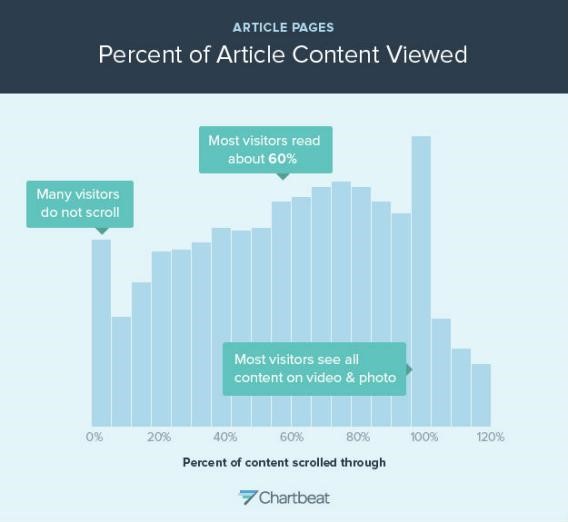
To keep people engaged on your site and to ensure they read your 2000-3000 word articles, you need to keep them interested all the way through.
Here are few ways to do that.
– Write Short and Powerful Introductions
People read blog posts and articles because they’re looking for answers. They’re not interested in your long, poetic and grammatically correct introductory paragraphs.
The first few lines of your blog post should not only catch the readers’ eye, but also tell them exactly what they’re in for.
For example, Jon Morrow is a master at creating introductions that hook readers.
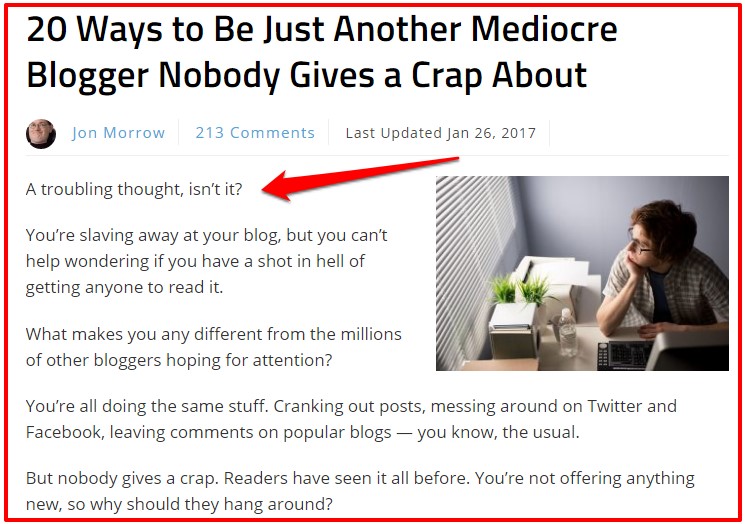
Look how he connects the title with the first few lines of his post and plays with the emotions of his readers.

He’s not only creative with his word selection, but also immediately tells the readers what the post is about.
It’s clearly more interesting than the “once upon a time” kind of long and boring introductions we so often see (read this really good resource on this topic by Hubspot)
As a general rule, I’d recommend keeping the introductions shorter than 100 words
– Add Personality to Your Content and Talk to Your Readers
Publishing your articles as “admin” or “XYZ Media” is an engagement killer.
Who wants to read an article by a faceless and voiceless author who writes blog posts like legal documents and uses “we” and “us” to refer to himself?
Even when you’re creating content for you company blog, it needs to have a face, a voice and real person behind it
Instead boring the hell out of your readers with heavy vocabulary, write as if you’re directly talking to them.
In fact, assume you’re talking to just one person, your ideal reader.
Use words like You, I, Me to make your content more conversational. Crack jokes, tell stories, use sarcasm and even an occasional rant.
Just be normal and sound like a real person rather than a bot.
– Add Data, Snapshots and Images to Your Content
Using numbers is one of the best ways to make your arguments stronger, heavier and more credible. So make bold claims in your content and share lots of data.
But don’t forget to back it up with solid references.
Even better, use graphical data to kill two birds with one stone. Content with visuals gets 94% more views as compared to plain text content.
For example, what looks more credible?
Simply saying that longer content is shared more frequently or adding a visual with it?
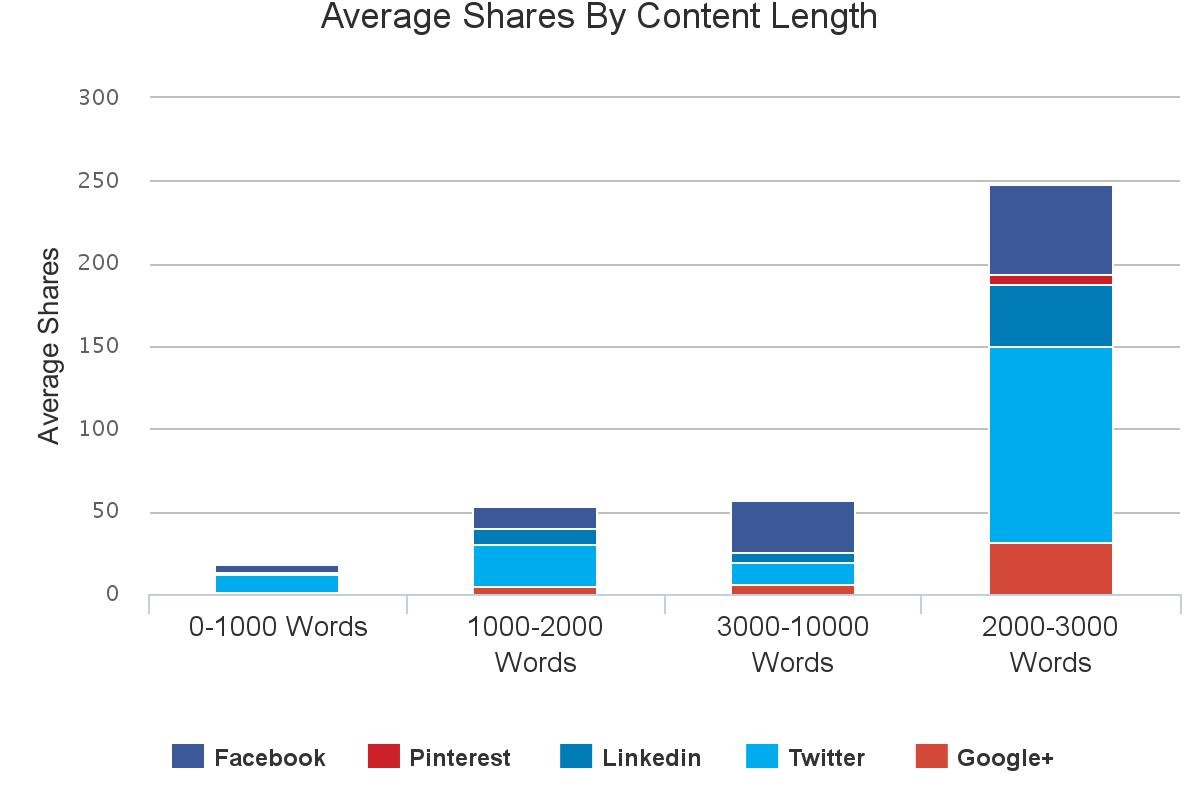
Source: Hubspot
There are millions of infographics on the web on all kinds of topics. Just make a quick Google search to find relevant infographics and use small portions from it in your content.
You can also use sites like Statista, Pew Research and other credible sources that publish data and studies in visual form.
If you can’t find anything else, just use snapshots to make your argument easier to understand (like I did in the first point)
– Quote Experts and Share Success Stories to Build Trust
What’s the easiest way to look trustworthy when you have no achievements yourself?
By hanging out with other trustworthy people!
In content marketing, you quote experts frequently in your content to appear an expert yourself.
The same happens when you cite success stories to support your arguments.
– Make It Actionable
If your reader doesn’t know the exact steps he needs to take after reading your content, you’re wasting his time.
Content marketing isn’t about sharing good to read content. It’s about creating resources that can help your readers take the next step.
As opposed to churning out 700 word opinionated articles, creating high quality content takes considerably more time and effort. But it’s a high return investment that’s necessary to grow your business.
4. Turn Readers into Subscribers with Laser-Focused Content Upgrades
People are lazy and rarely take action unless they’re firmly pushed for it.
No matter how useful and actionable your content is, you’ll struggle get subscribers if you don’t remind your readers regularly to join your list.
High quality content makes your job easier, but you still need systems in place to capture leads.
Using targeted content upgrades is one of my favorite ways to do that.
A content upgrade is an additional resource (an eBook, a checklist, a worksheet, a video or any other form of content) offered as a bonus to your readers in exchange for their email address.
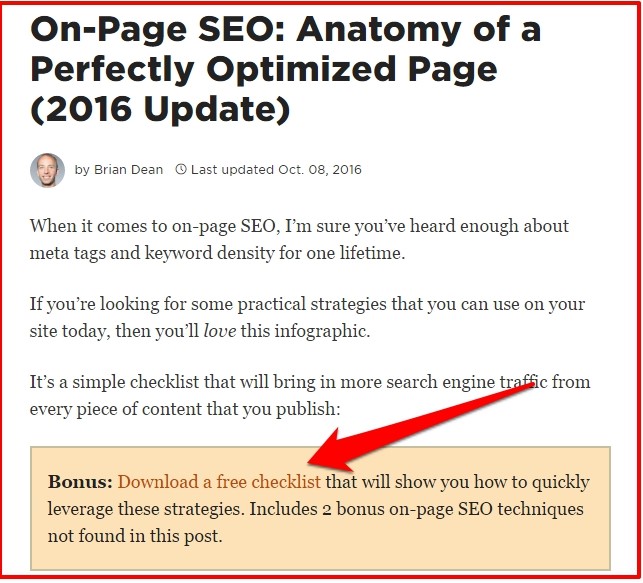
More blog readers convert into email subscribers because of content upgrades since they’re closely aligned with the article.
Plus, content upgrades are usually placed within the body of the content, so it’s easier to convince the readers to click on them.
Brian Dean, for example, increased his email signups by 785% by adding content upgrades to his most popular posts.
Bryan Harris, another leading marketer, credits content upgrades for more than 70% of his subscriber base.
And here’s the best part.
Creating and setting up a content upgrade is much easier than a regular lead magnet. Most marketers I know use small checklists or worksheets as content upgrades.
You can use free tools like SumoMe to set up a content upgrade in no time.
Wrapping Up
The effectiveness of content marketing is unquestionable. If you invest time in creating high quality content and create systems that automatically convince your readers to join your email list, content marketing can quickly become your most profitable marketing strategy.
Do you have a content strategy for your business? Are you having trouble turning readers into subscribers?
Share your thoughts in the comments section and I’d be happy to respond.
Image credits: Pixabay
